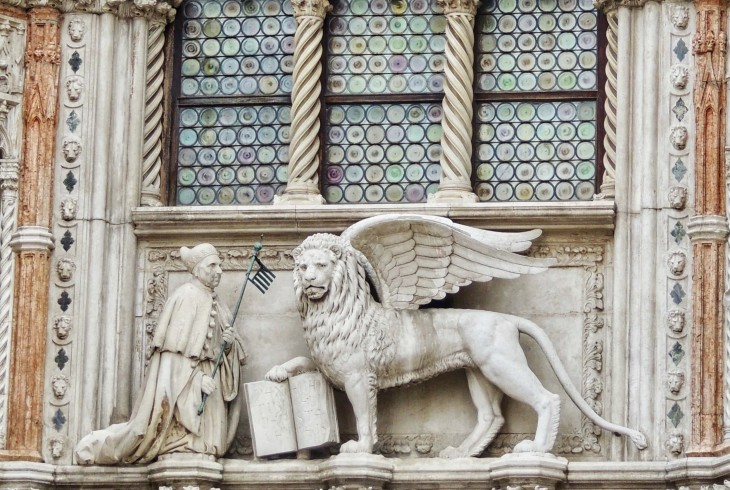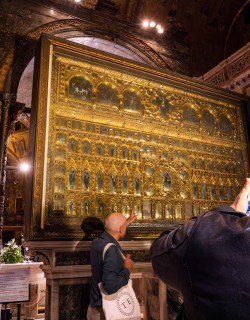Last week on our blog we took a look at how to visit the Doge’s Palace in Venice, one of the absolute must-see sites in the Floating City. But what do you need to look out for when you get there? From grand ceremonial chambers to labyrinthine prisons, stunning Renaissance staircases and what might just be the world’s most famous bridge, the Doge’s Palace offers up a vivid picture of the opulence and intrigue of Venice during its glorious golden age.
Discover the highlights of the Doge’s Palace with our in-depth guide below! These are twelve things you don’t want to miss.
-
The Porta della Carta
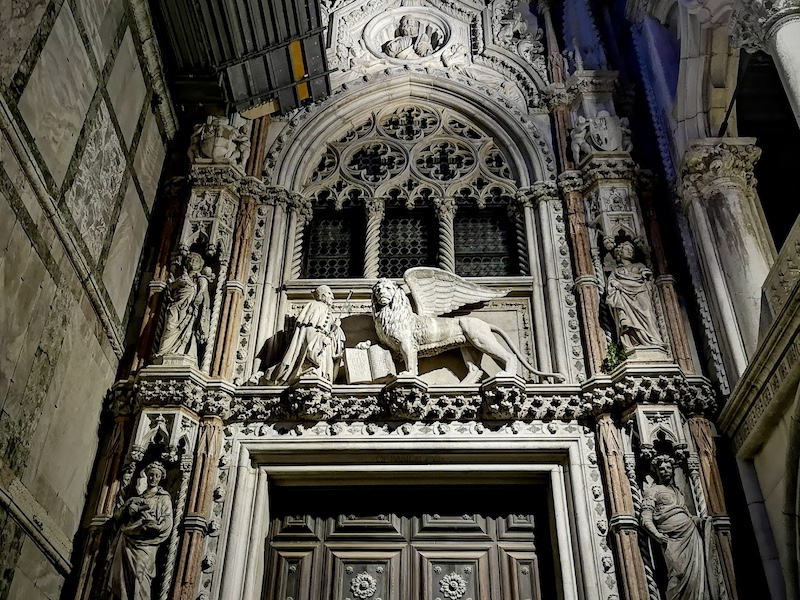
One of the main entrances into the Doge’s Palace complex is via the extraordinarily elaborate Porta della Carta. Designed in the 15th century by Bartolomeo Bon, the doorway is considered one of the key works of Renaissance architecture in Venice. Carved from Istrian marble, the portal is surmounted by a sculpture of Doge Francesco Foscari kneeling in front of the winged lion of St. Mark, protector of Venice. The door gets its name from the fact that Venetian bureaucrats would receive and process paper (carta) documents here.
-
The Inner Courtyard
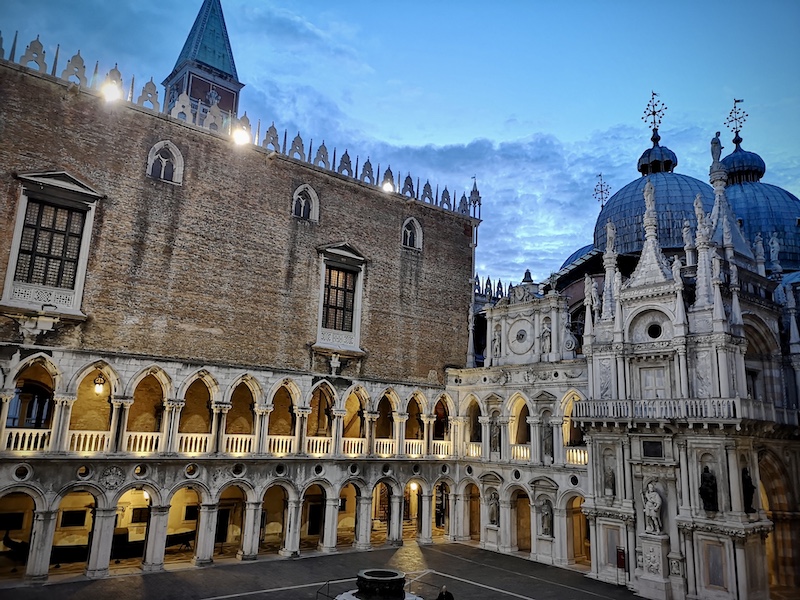 Entering through the Porta della Carta, the breathtaking inner courtyard of the Doge’s Palace offers up a seriously impressive introduction to the splendors that lie in wait within Venice’s most important civic building. Surrounded by sweeping loggias and elegant porticoes, the architecture of the courtyard is a dizzying mishmash of Gothic and Renaissance styles, testament to its centuries-long construction.
Entering through the Porta della Carta, the breathtaking inner courtyard of the Doge’s Palace offers up a seriously impressive introduction to the splendors that lie in wait within Venice’s most important civic building. Surrounded by sweeping loggias and elegant porticoes, the architecture of the courtyard is a dizzying mishmash of Gothic and Renaissance styles, testament to its centuries-long construction.
The first part of the courtyard to be built was its southern side, whose facade features classic Gothic ogive arches and pinnacles extending over a two-storey loggia. The eastern facade by contrast takes us straight to the glory days of the Renaissance: a magnificently elegant ensemble of classical orders, columns and pilasters enlivened by rich sculptural details.
The courtyard was accessible by the Venetian public, who came here to draw water from the two beautiful bronze wells that stand at its center. The courtyard also played host to various Venetian festivals and ceremonies.
-
The Scala dei Giganti
Another masterpiece of Renaissance architecture, the sweeping marble Scala dei Giganti (Staircase of the Giants) owes its intriguing moniker to the colossal statues of Mars and Neptune that stand guard at its summit. Designed by Antonio Rizzo in the late 15th century, the staircase leads from the inner courtyard into the palace and played a very important role indeed in the history of Venice: it was here that new Doges were officially crowned as head of state in an investiture ceremony during which they swore undying loyalty to the Serenissima. The towering statues themselves are the work of Jacopo Sansovino, and seek to demonstrate the Venetian Republic’s continuing hegemony over both land and the sea.
-
The Golden Staircase (Scala d’Oro)
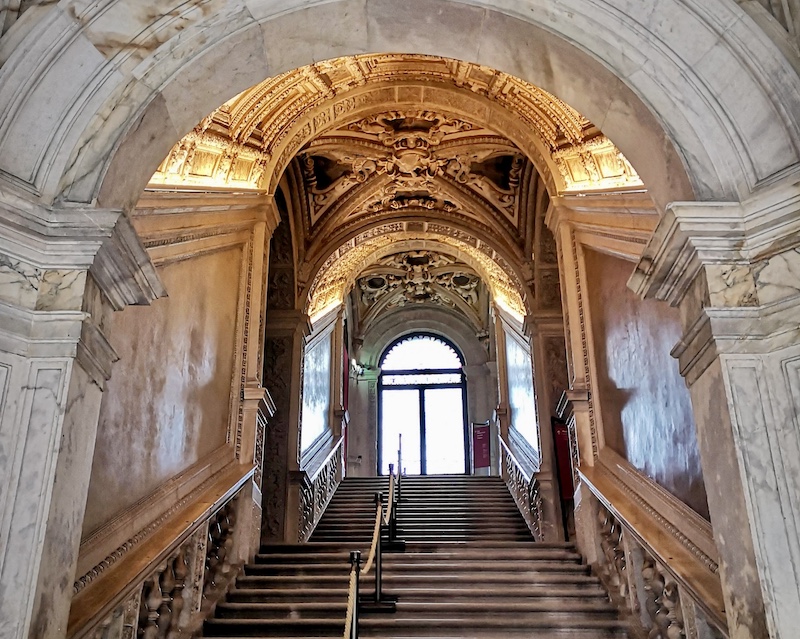
The Scala d’Oro, or Golden Staircase, continues the ascent begun by the Scala dei Giganti deeper into the heart of the Doge’s Palace. Designed by Jacopo Sansovino at the behest of Doge Lorenzo Priuli in 1556, this lavishly decorated staircase constituted the formal ceremonial entrance to the private apartments of the Doge himself, and was used by visiting dignitaries and senior officials of the Venetian state.
As you climb the beautiful flight, take a look upwards and you’ll soon understand why it’s known as the Golden Staircase. The ceiling is richly ornamented with gilded stucco and gold leaf, the work of artist Alessandro Vittoria, and offers a dazzling insight into the limitless wealth of the Venetian city state. Sculptures portraying the classical heroes Hercules and Atlas complete the spectacular ensemble.
-
The Doge’s Apartments
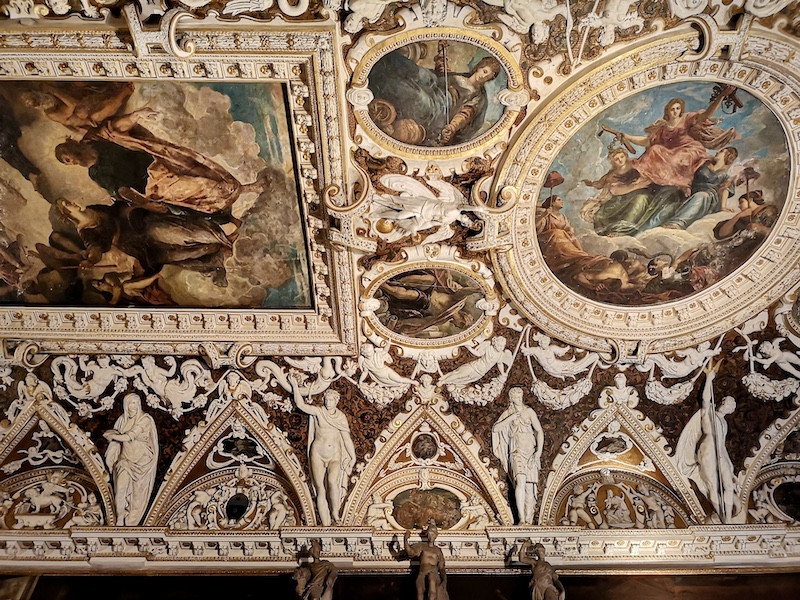
The Palazzo Ducale was the political and administrative headquarters of the Venetian City State, but just as importantly it was the private home of the ruling Doge and his family. 120 Doges were elected by the Venetian State over the course of its long history, from Paoluccio Anafesto in the year 697 to the last doge Ludovico Manin, who abdicated in 1797 when the French troops of Napoleon stormed the city.
Accessed by the Scala d’Oro, the Doge’s apartments unfold over a series of elegant rooms decorated with imposing carved wooden ceilings, lavish stucco, frescoes, portraits of former doges and furnishings that the sitting Doge would traditionally bring from his own family residence. Among the highlights is the Sala dello Scudo, a room filled with detailed maps that showcase the vast territorial reach of the Venetian Empire during its height as well as paintings depicting the daring journeys of Venice’s most renowned explorers. The Erizzo Room and Audience Room, meanwhile, feature beautiful marble fireplaces.
-
The Chamber of the Great Council (Sala del Maggior Consiglio
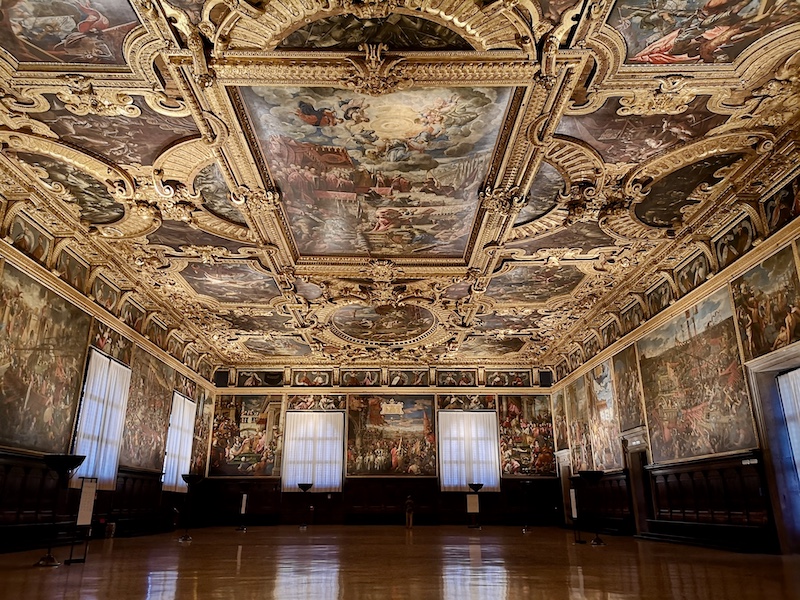
The Chamber of the Great Council was the nerve center of the Doge’s Palace. The Great Council itself was the most important political body in the Venetian state, a group that comprised all males over the age of 25 hailing from the city’s noble families, regardless of wealth, reputation or status. This council, usually made up of 1,000-2000 members, was as close to democracy as the Serenissima got, and was tasked with upholding the laws, values and ideals of the Republic. In addition to debating the most important issues of state, the chamber was also where the council voted on the election of the new Doge at one stage in a highly complex process.
Reflecting the importance of the events that took place here, the immense hall is one of the largest and most opulent rooms in all of Europe. Measuring 53 meters long and 25 meters wide, the chamber is richly decorated by paintings from the brushes of the greatest Venetian artists: while works by Pisanello, Gentile da Fabriano, Carpaccio and Bellini perished in a 16th century fire, masterpieces by Veronese, Tintoretto and Titian compensate for the loss.
Most important of all is Tintoretto's Paradiso, a massive 22-meter-wide depiction of heaven where a central Christ surrounded by a multitude of angels, saints, and figures from Venetian history. The decisions of the Great Council, Tintoretto seems to be telling us, are guided by God himself. And looking at the immense glory of Venice as displayed in the Doge’s Palace, who could disagree?
-
The Chamber of the Council of Ten (Sala del Consiglio dei Dieci)
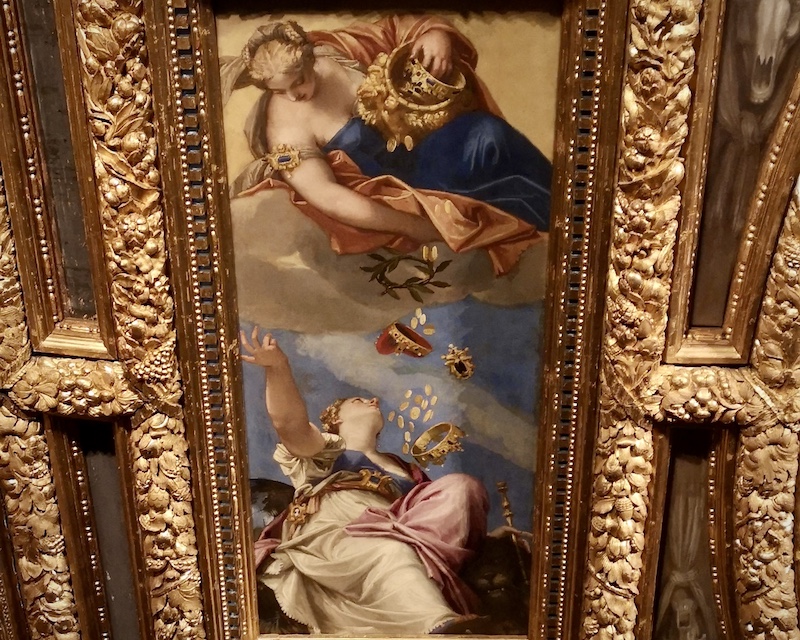
The Council of Ten was a shadowy and powerful Venetian governing body that was set up in 1310 to prosecute a group of conspirators after a failed coup attempt. Mission creep set in, and the council soon found itself as a permanent fixture of political life in Venice charged with overseeing all imaginable aspects of public order and state security.
Due to its sweeping powers and propensity to conduct its hearings in private, the Tribunal soon gained a reputation as a secretive and ruthless tool of oppression in the service of the Venetian state, not bound by the laws of the Republic. The Council of Ten sat in session alongside the Doge himself and his six most trusted counselors in this room, beautifully decorated by a team of artists including Gian Battista Ponchino and a young Paolo Veronese.
At the center of the ceiling the great god Jove flings lightning bolts at the personification of Vice, reflecting the Council’s avowed aim of rooting out wrongdoing, corruption and treason in Venice. Elsewhere, Juno showers Venice with gifts and gold.
-
The Chamber of the Scrutinio
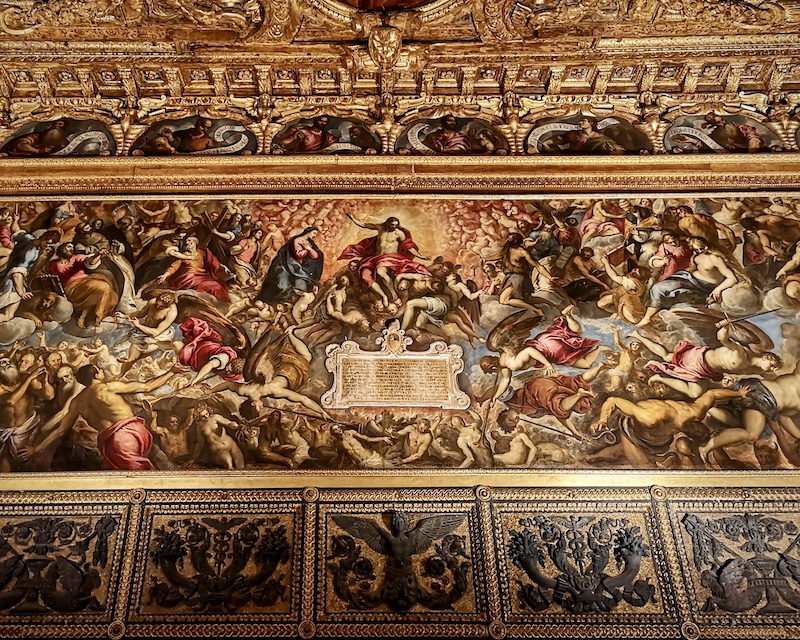
Originally built to house the collection of precious manuscripts donated to the Venetian State by the great poet Petrarch and the humanist scholar Cardinal Bessarione, in the 16th century this grand chamber also became the site where the Venetian hierarchy deliberated and voted on the various elections that punctuated the Venetian political calendar.
Grand scenes of Venetian military triumphs adorn the ceiling, including various successful battles against the feared Turkish fleets - look out in particular for Andrea Vicentino’s depiction of the Battle of Lepanto, arguably the most important military victory in Venetian history.
-
The Senate Chamber

Where the Great Council included all adult males from Venice’s established families, the Senate was a much more exclusive affair. This subcommittee was made up of the most prominent and wealthiest citizens in the city, and had broad control over matters of public policy, trade and the fiscal wellbeing of the state. They met with the Doge in this grand room, redesigned in the 1580s after a devastating fire, surrounded by paintings by Venetian art powerhouses Tintoretto and Palma il Giovane.
-
The Prisons
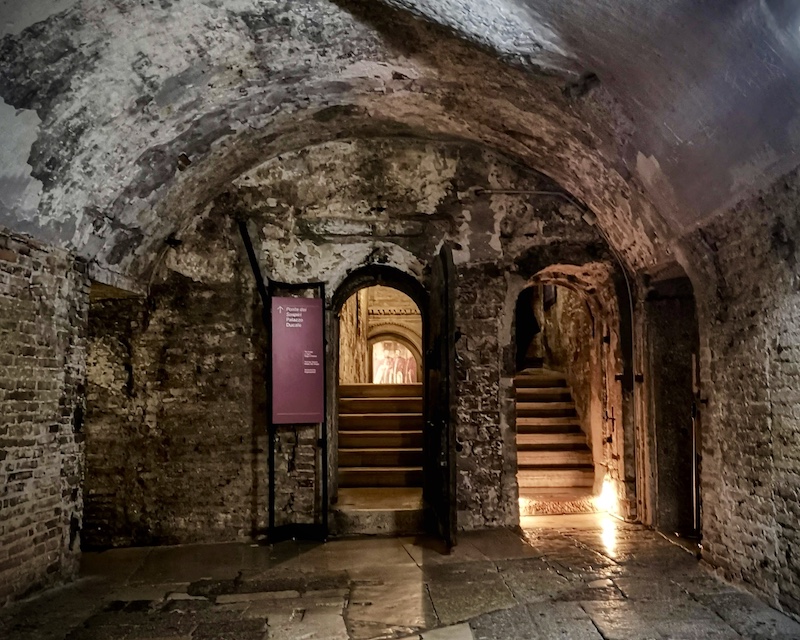
The notorious prisons of the Venetian Republic were housed right in the Doge’s Palace itself until the late 16th century, when a new prison complex was finally built on an adjoining site just across the Rio del Palazzo canal by Antonio Contin. Conditions in the cells known as “pozzi”, or wells, were particularly desperate - cramped, damp, and poorly ventilated, they were a breeding ground for disease and despair.
The New Prisons, linked to the Palazzo Ducale via the Bridge of Sighs, were much less harsh, and featured more spacious and sanitary cells. Nonetheless, as you walk through the warren of passages and rooms today, it remains clear this was a place you really didn’t want to end up in. To make matters worse, prisoners were often held indefinitely without trial and without being told what they were imprisoned for - as recounted by the adventurer and lover-extraordinaire Cassanova, who famously exited the prison via an audacious escape.
-
The Bridge of Sighs
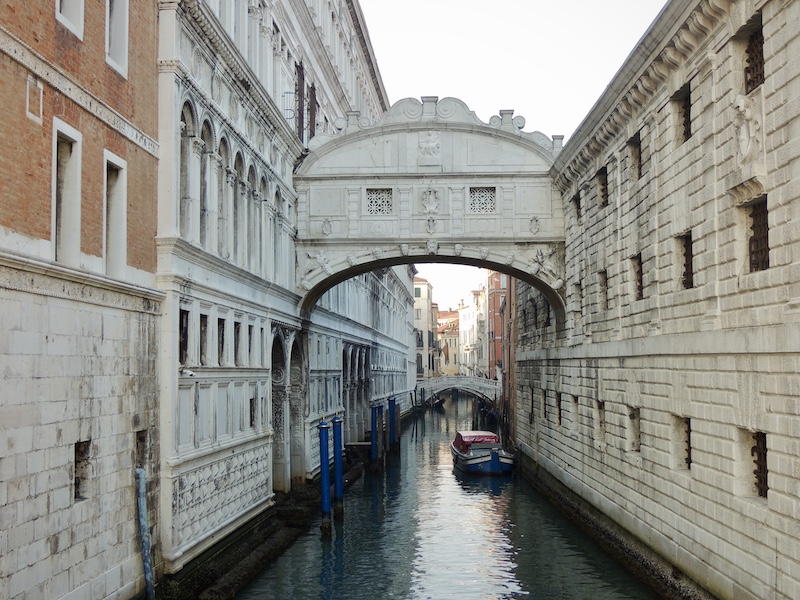
The iconic Bridge of Sighs is a narrow covered walkway connecting the Doge’s Palace to the New Prisons. Completed in 1614, the elegant neoclassical bridge was the work of the architect Antonio Contino, and was designed to transport prisoners from their cells to the magistrate's chambers where they stood trial and back again. Built from white Istrian limestone, the bridge features ornate classical decorations, including scrolls, pilasters, and sculpted heads that grimace down at the canal.
Two small windows, framed by intricate stone latticework, offer partial views of the Venetian lagoon. Despite being known to all as the Ponte dei Sospiri, or Bridge of Sighs, the walkway only earned its romantic nickname in the 19th century, when overactive imaginations pictured downtrodden prisoners sighing with regret as they glimpsed the splendor of Venice out of the little windows as they headed towards trial or imprisonment.
For more on the Bridge of Sighs, check out our dedicated article here: All About the Bridge of Sighs.
-
The Armoury
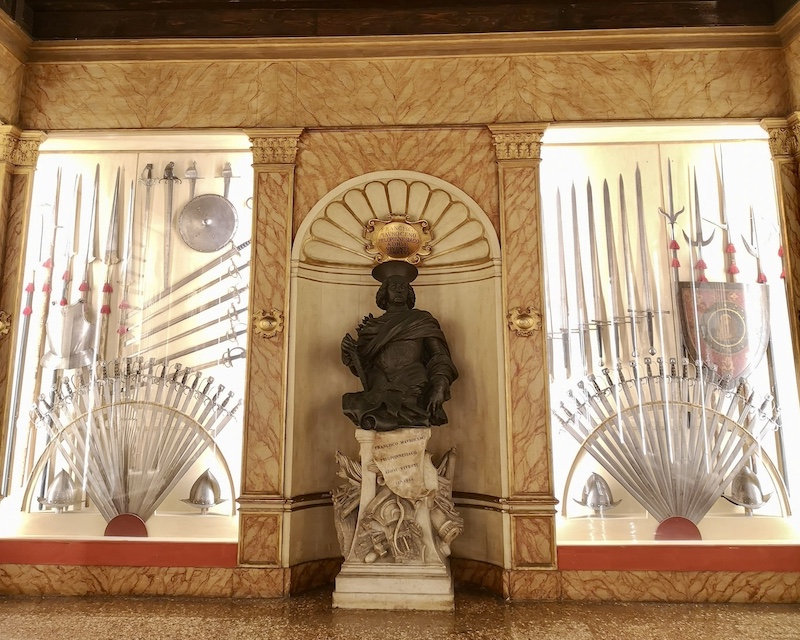
The Doge’s Palace Armoury houses an impressive collection of military weapons and equipment that were stockpiled here for use by the Palace’s Guards. If you can think of a weapon, you’ll probably find it here - swords and maces, crossbows, pikes and muskets all make an appearance, as do a number of artifacts taken from Turkish forces during the long and bitter wars between the two empires.
Perhaps most impressive of all are the suits of armor on show. Whilst some were designed to be worn in battle, many others were intended for ceremonial use, which explains their intricate decorations. Look out for the suit of armor that belonged to the feared mercenary Gattamalata, who fought for Venice in a series of daring military engagements, as well as a small suit of armor that likely belonged to a dwarf.
-
The Chamber of Torment
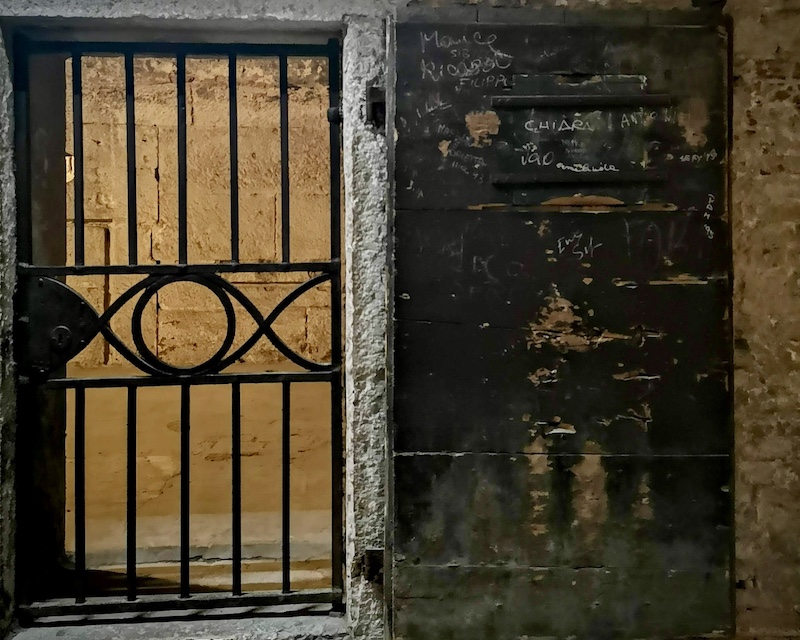
We finish our guide to what to see at the Doge’s Palace on a dark note. It doesn’t take much imagination to picture what went on in the chillingly named Chamber of Torment: this was where prisoners were tortured in the presence of magistrates who personally directed their brutal interrogations. The most common method of torture deployed in the Venetian Republic was the use of a rope by which the detainee was stretched and pulled out of shape until he or she confessed. Thankfully by the 18th century this aspect of the Venetian penal system had been largely abolished.
We hope you enjoyed our guide to what to see at the Doge’s Palace! With so much to see here, we think that a guided tour is the best way to fully appreciate the fascinating history, art and architecture of this special place. To feel the Doge’s Palace come alive, check out our expert-led tour here: Essential Venice Tour.
MORE GREAT CONTENT FROM THE BLOG:
- How to Visit the Doge's Palace in Venice
- Everything You Need to Know to Visit Venice
- Your Perfect One Day Venice Itinerary
- Where to Stay in Venice
- What to Do on Your First Trip to Venice
- How to Visit St. Mark's at Night
- 10 Romantic Things to do in Venice
- The Amazing Islands of Venice
- 10 Dishes You Need to Try in Venice
